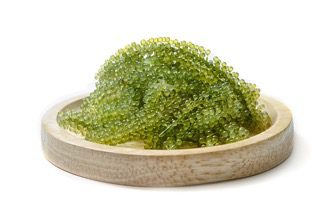

Sea grapes, also known as Caulerpa lentillifera, are a type of edible seaweed that are commonly used in Asian cuisine. They are native to the Indo-Pacific region but are now cultivated in various parts of the world. Sea grapes are typically consumed raw and have a slightly salty taste and a crunchy texture. They are an affordable and easy-to-find option for pet owners who want to introduce their dogs to something new and nutritious.
Sea grapes are a rich source of vitamins A and C, which can help boost a dog’s immune system. They also contain essential minerals such as potassium, calcium, magnesium, iron, and zinc. With their low cellulose content, sea grapes are easily digestible and can support healthy digestion in dogs. The polyunsaturated fatty acids found in sea grapes can help promote heart health, while their high fiber content can aid in maintaining healthy bowel movements. Additionally, the phenolic compounds, polysaccharides, oligosaccharides, and siphonaxanthin in sea grapes have antioxidant and cancer-preventing effects.
While sea grapes are generally safe for dogs to eat in moderation, their high sodium content can be harmful if consumed excessively. There is limited research on the exact suitability of feeding sea grapes to dogs, so it’s best to consult with a veterinarian before introducing them to your pet’s diet.
As with any new food, it’s important to introduce sea grapes to your dog’s diet gradually and in small amounts. A recommended serving size for sea grapes is approximately one or two grapes per day for small dogs, and up to four grapes per day for larger breeds. It’s also important to ensure that your dog has access to plenty of fresh water to help flush out any excess sodium.
Sea grapes are generally considered safe for dogs to eat, as they are packed with vitamins, minerals, and compounds that offer various health benefits. However, they contain high levels of sodium, which can lead to sodium poisoning if consumed excessively.
Dogs can benefit from the vitamins, minerals, and antioxidants found in sea grapes. They can support healthy digestion, boost the immune system, promote heart health, and prevent cancer. However, it's important to be mindful of their high sodium content, which can cause sodium poisoning if consumed excessively. As always, it's best to consult with a veterinarian before adding any new food to your dog's diet.
To serve sea grapes to your dog, start with a small amount and gradually increase the serving size over time. Suggested serving sizes are one or two grapes per day for small dogs and up to four grapes per day for larger breeds. Make sure to provide plenty of fresh water to help flush out any excess sodium.
If you're looking for alternatives to sea grapes, you might consider fruits like apples or blueberries, which are also rich in vitamins and antioxidants. You may also want to explore other types of seaweed that are safe for dogs, such as nori or kombu.
Have you ever tried feeding sea grapes to your dog? How did they like them? As always, it's important to pay attention to your dog's reactions to new foods and consult with a veterinarian if you have any concerns. We hope your furry companion enjoys the many health benefits of sea grapes!